Modern interior design has evolved into a sophisticated approach that prioritizes simplicity, functionality, and visual clarity.
Today’s modern aesthetic emphasizes clean lines, uncluttered spaces, and carefully selected materials that create harmony throughout the home.
This design philosophy focuses on quality over quantity, choosing fewer but more impactful pieces that serve both practical and aesthetic purposes.
The appeal of modern interiors lies in their ability to create calm, organized environments that feel both spacious and welcoming.
Open layouts maximize natural light and flow, while thoughtful material choices like natural wood, stone, and metal add texture without overwhelming the senses.
These 11 inspiring modern home interior ideas will show you how to achieve this balanced aesthetic in your own space, combining contemporary style with livable comfort that works for real families and everyday life.
List of 11 Inspiring Modern Home Interior Ideas
Explore these carefully curated modern interior concepts that combine contemporary aesthetics with practical functionality to create stylish, comfortable living spaces for today’s homes.
1. Embrace Natural Light with Minimal Window Treatments

Natural light serves as the foundation of modern interior design, transforming spaces into bright, airy environments that feel larger and more inviting.
Large unobstructed windows or simple sheer curtains allow maximum light penetration while maintaining privacy when needed.
This approach eliminates heavy drapery that can make rooms feel closed off and dated.
Light enhances the spatial openness that defines modern interiors by eliminating shadows and creating seamless visual flow between indoor and outdoor spaces.
Consider using reflective surfaces like mirrors, glossy finishes, or metallic accents strategically placed to bounce light around the room and amplify its impact.
This technique doubles the effect of available natural light while adding depth and dimension to your space.
2. Add Depth with Layered Neutrals
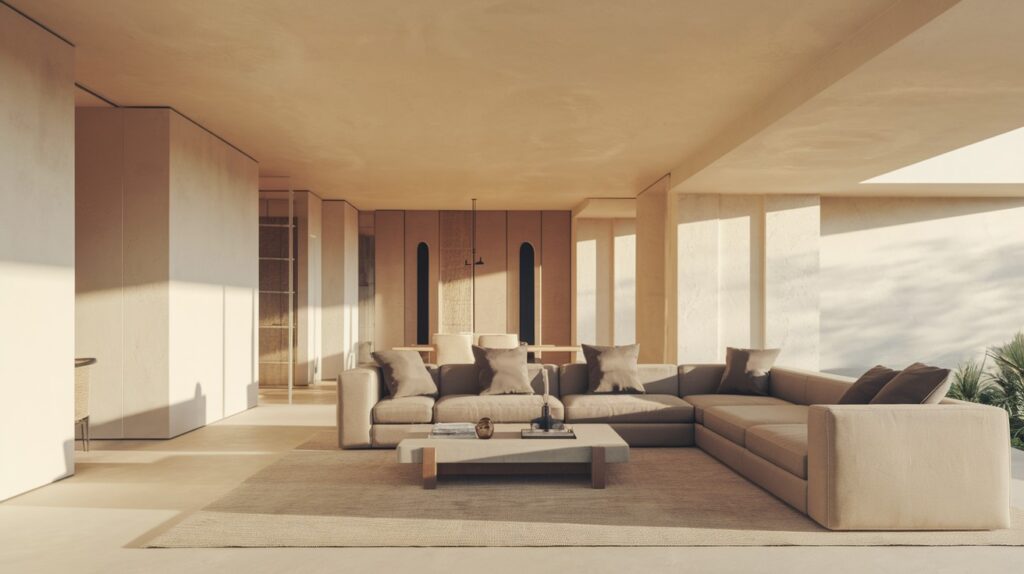
Neutral color palettes form the backbone of modern design, but layering different tones prevents spaces from feeling flat or sterile.
Off-whites, warm taupe, sophisticated greige, and soft charcoal create a rich foundation that feels both timeless and contemporary.
These colors work together to establish depth and visual interest without overwhelming the senses.
The key to successful neutral layering lies in incorporating varied textures that keep the look engaging and dynamic.
Combine smooth surfaces with rough textures, matte finishes with subtle sheens, and soft fabrics with harder materials to create contrast within your neutral scheme.
This approach adds warmth and dimension while maintaining the clean, uncluttered aesthetic that modern design demands.
3. Invest in Statement Lighting

Lighting serves as both functional necessity and artistic element in modern interiors, making it worth investing in pieces that make visual impact.
Sculptural pendant lights or sleek linear fixtures become focal points while providing essential illumination for daily activities. ‘
These statement pieces often serve as the room’s primary decorative element in minimalist spaces.
Create balanced lighting by combining ambient, task, and accent options throughout your space.
Consider LED fixtures and smart lighting systems that offer energy efficiency while allowing you to adjust brightness and color temperature throughout the day.
This flexibility supports both productivity and relaxation while reducing environmental impact and utility costs.
4. Incorporate Sleek Built-In Storage
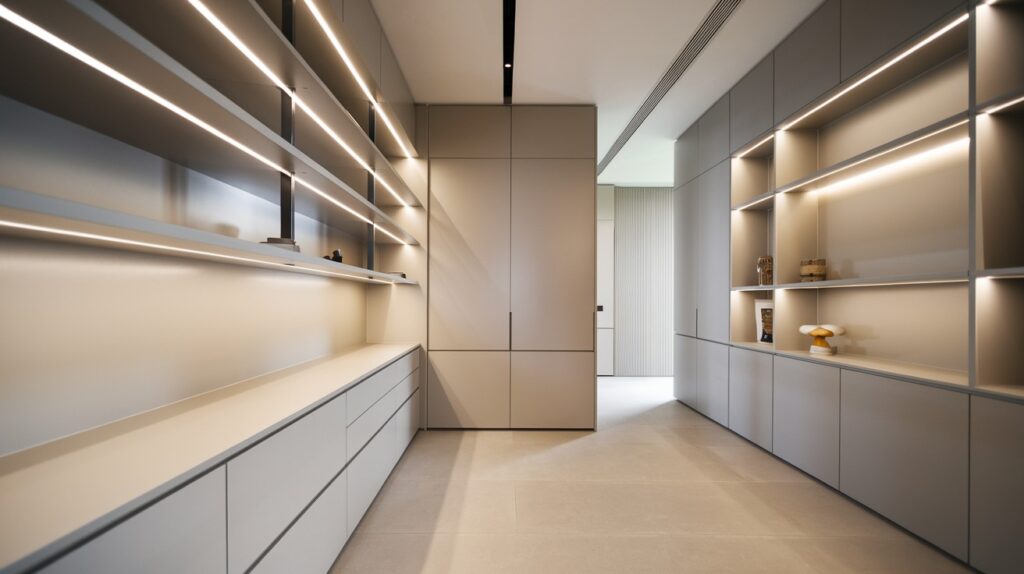
Custom built-in storage solutions maximize your home’s square footage while maintaining the clean lines essential to modern design.
Floor-to-ceiling shelving and hidden cabinetry eliminate visual clutter by providing designated spaces for everything while creating seamless integration with your room’s architecture.
Choose materials that either blend invisibly with your walls or create subtle contrast through different textures or tones.
Built-ins offer superior space efficiency compared to freestanding furniture while providing the custom look that makes modern spaces feel intentional and well-planned.
This investment pays dividends in both functionality and resale value.
5. Use Large-Scale Wall Art
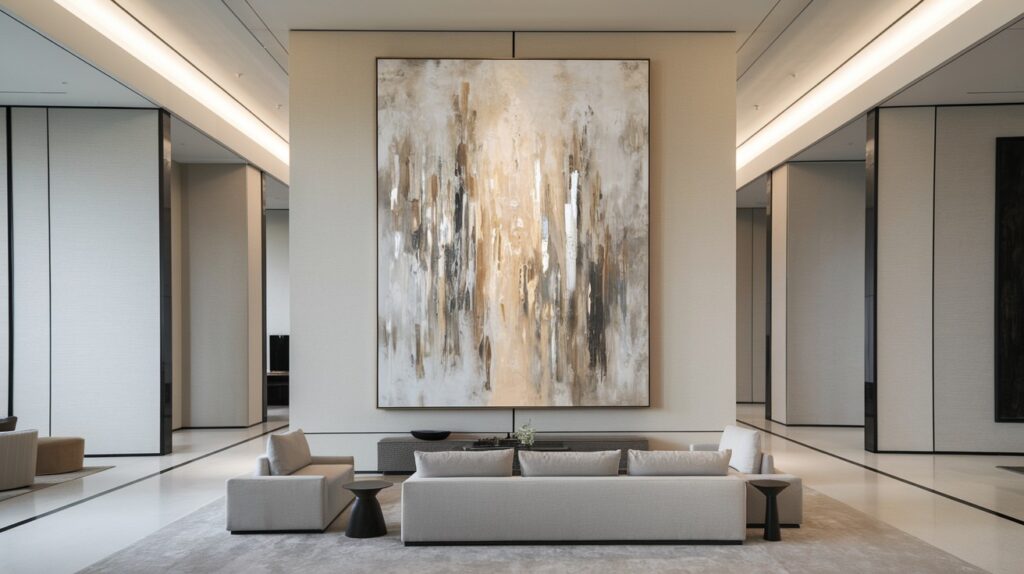
Oversized artwork creates dramatic impact in modern spaces while maintaining the simplicity that defines this aesthetic.
Large pieces eliminate the need for multiple smaller artworks that can create visual chaos, instead providing single focal points that anchor entire rooms.
Abstract compositions, striking photography, or bold geometric designs work particularly well in contemporary settings.
Keep framing simple and uniform to maintain the clean aesthetic that modern design requires.
Black, white, or natural wood frames in consistent styles create cohesion when displaying multiple pieces, while floating mounts offer an even more minimalist presentation that lets the artwork speak for itself.
6. Choose Low-Profile, Functional Furniture

Modern furniture emphasizes clean edges, slim silhouettes, and practical functionality over ornate decoration.
Modular sectionals adapt to different configurations as your needs change, while floating consoles and minimalist coffee tables maintain visual lightness that keeps spaces feeling open and uncluttered.
Multi-purpose furniture becomes especially valuable in smaller layouts where every piece must work harder.
Ottoman storage, extendable dining tables, and nesting side tables provide flexibility while maintaining the streamlined appearance that defines modern style.
This approach maximizes functionality without sacrificing the clean aesthetic that makes modern spaces so appealing.
7. Play with Contrasting Materials

Material contrast brings character and visual interest to modern spaces without adding decorative clutter.
Pair matte finishes with glossy surfaces, combine warm wood tones with cool metals, or contrast rough textures with smooth ones to create dynamic relationships that feel both current and inviting.
These material combinations prevent modern spaces from feeling cold or sterile while maintaining their sophisticated simplicity.
The interplay between different textures and finishes adds depth and personality that makes rooms feel lived-in and welcoming rather than showroom-perfect.
8. Add Greenery for a Fresh Look
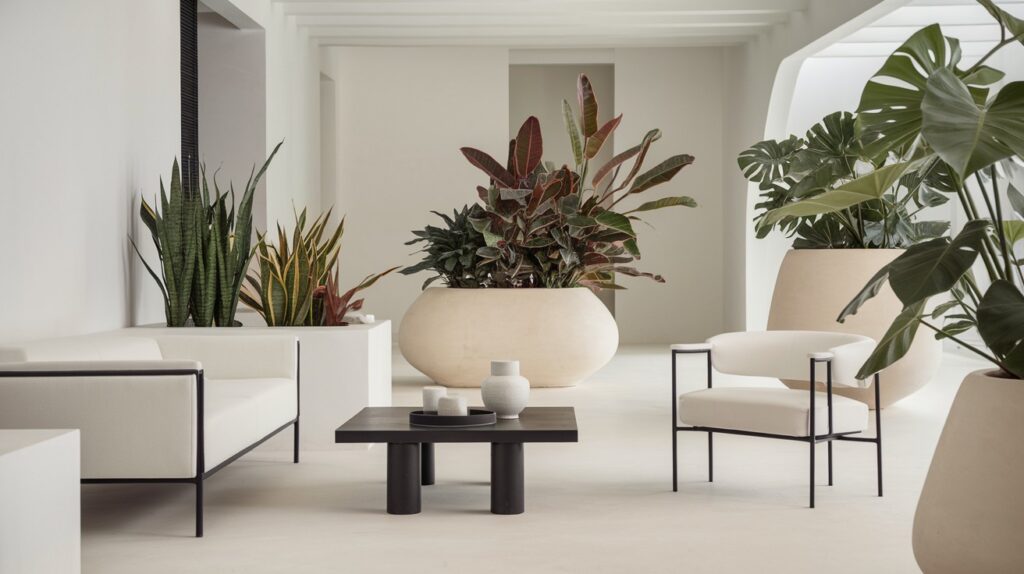
Indoor plants bring life and natural beauty to modern interiors while improving air quality and creating connections to nature.
Snake plants, rubber trees, and other architectural specimens complement clean-lined furniture and provide organic contrast to hard surfaces and geometric forms.
Choose planters with simple, sculptural forms that complement your modern aesthetic rather than competing with it.
Low-maintenance plant varieties work best for busy lifestyles, ensuring your green additions enhance rather than complicate your daily routine while maintaining their visual appeal year-round.
9. Create a Gallery Nook or Accent Wall
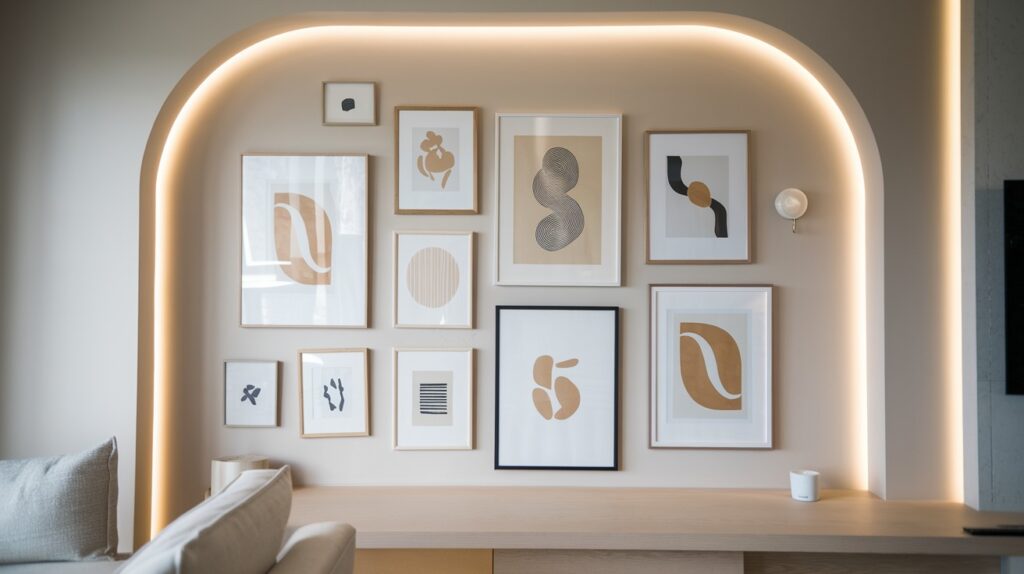
Designated display areas allow you to personalize modern spaces while maintaining overall cohesion and visual order.
Use repetition or symmetry in artwork placement or shelving arrangements to create intentional compositions that feel curated rather than random.
These focal areas become conversation starters while expressing your personality within the modern framework.
Consider paint, subtle wallpaper, or wood paneling as backdrop treatments that define these special areas without overwhelming the space.
The contrast between display zones and neutral surrounding areas creates visual hierarchy that guides attention while maintaining the balanced composition essential to modern design.
10. Go Bold with a Single Color Pop

One vibrant color can energize an entire modern space when applied strategically and sparingly.
This approach maintains the clean, uncluttered aesthetic while adding personality and visual excitement that prevents spaces from feeling too serious or sterile.
Apply your chosen bold color through easily changeable elements like throw pillows, a single accent chair, or striking artwork that can evolve with your preferences over time.
Pair bright hues with your neutral foundation to maintain balance and prevent the color from overwhelming the space’s serene modern atmosphere.
11. Keep the Layout Open and Flexible
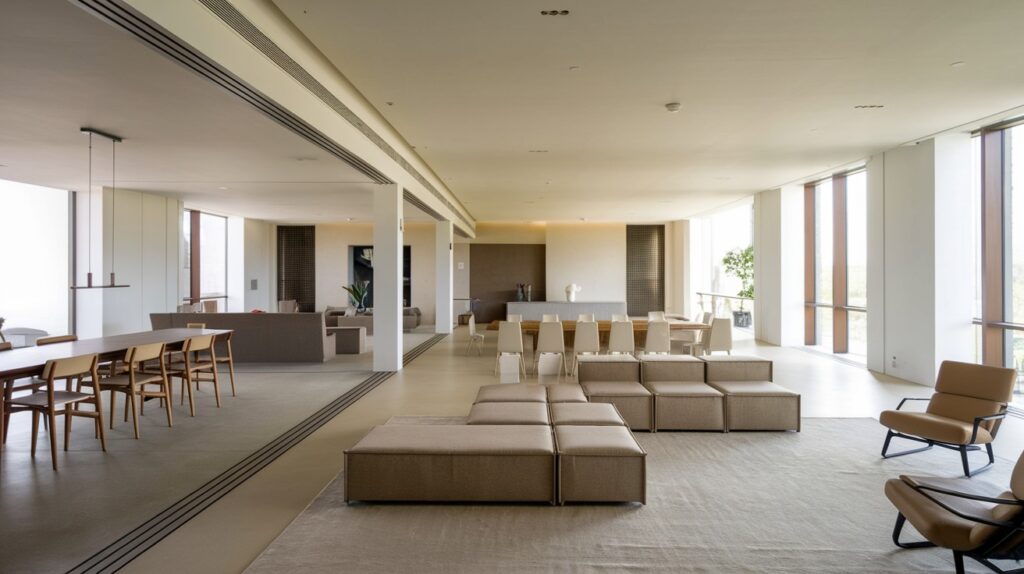
Open, flexible layouts define modern living by creating better flow and maximizing the sense of space throughout your home.
Floating furniture arrangements allow for easy reconfiguration while maintaining clear pathways that make rooms feel larger and more functional.
Create distinct zones for different activities within open spaces using furniture placement, area rugs, or lighting changes rather than physical barriers.
This approach maintains visual continuity while providing practical organization, and the mobility and breathing room inherent in modern design support both daily life and entertaining needs.
How to Get Started with Modern Interior Updates
Starting your modern interior transformation becomes manageable when you focus on one room at a time.
Choose a frequently used space like your living room or bedroom where you’ll immediately appreciate the improvements while staying within budget and learning what works for your lifestyle.
Assess your current layout to identify clutter points and awkward furniture placement that disrupts flow.
Remove unnecessary items, reposition furniture for better traffic patterns, and consolidate storage solutions. This cost-free evaluation provides valuable insights for future design decisions.
Select two or three modern design concepts that appeal to you and implement them gradually rather than attempting a complete overhaul.
Start with simple updates like statement lighting or maximizing natural light, then progress to furniture or color changes as your confidence grows.
Prioritize functionality and comfort alongside visual appeal to ensure your updates improve daily life rather than just appearance.
Set realistic budgets and timelines that allow for thoughtful research and implementation, preventing costly mistakes that don’t serve your actual needs.
Final Thoughts
Modern interior design proves that small, thoughtful changes can create significant impact without requiring complete home renovations.
The beauty of this approach lies in its flexibility and accessibility, allowing you to transform your space gradually while respecting both your budget and personal style preferences.
Feel confident experimenting within your comfort zone, knowing that modern design principles adapt to various tastes and lifestyles.
Start with simple updates like lighting changes or neutral color schemes, then build upon these foundations as your confidence grows.
Remember that modern interiors continue evolving with time, incorporating new materials, technologies, and lifestyle needs while maintaining their core emphasis on simplicity and functionality.
The key to successful modern design lies in creating spaces that look beautiful while supporting your daily life, ensuring your home remains both stylish and genuinely livable for years to come.
Frequently Asked Questions
What defines modern interior design style?
Modern interior design emphasizes clean lines, open layouts, and minimal clutter with a focus on functionality and simplicity. It features neutral color palettes, natural materials, and carefully selected furniture pieces that serve both practical and aesthetic purposes.
How can I make my home look more modern on a budget?
Start with simple updates like adding statement lighting, incorporating more natural light, and decluttering your space to create cleaner lines. Paint walls in neutral tones and add one or two modern furniture pieces rather than replacing everything at once.
What colors work best in modern interior design?
Neutral colors form the foundation of modern design, including whites, grays, beiges, and soft earth tones that create calm, sophisticated spaces. Add depth through layered neutrals and consider one bold accent color for visual interest without overwhelming the clean aesthetic.
How do I choose furniture for a modern home?
Look for pieces with clean edges, slim silhouettes, and minimal ornamentation that emphasize function over decoration. Choose multi-purpose furniture and modular pieces that offer flexibility while maintaining the streamlined appearance essential to modern style.
Can I mix modern design with other styles?
Modern design works well when combined with other aesthetics through careful material choices and consistent color schemes. Focus on maintaining clean lines and uncluttered spaces while incorporating elements from other styles through accessories, artwork, or accent pieces.

